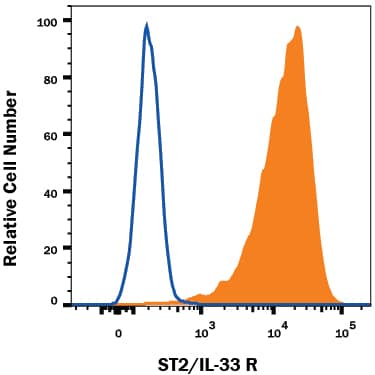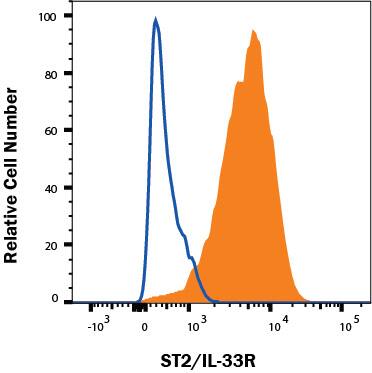Mouse ST2/IL-33R PE-conjugated Antibody
R&D Systems, part of Bio-Techne | Catalog # FAB10041P


Key Product Details
Species Reactivity
Validated:
Cited:
Applications
Validated:
Cited:
Label
Antibody Source
Product Specifications
Immunogen
Ser27-Arg332
Accession # P14719
Specificity
Clonality
Host
Isotype
Scientific Data Images for Mouse ST2/IL-33R PE-conjugated Antibody
Detection of ST2/IL-33 R in P815 Mouse Cell Line by Flow Cytometry.
P815 mouse mastocytoma cell line was stained with Rat Anti-Mouse ST2/IL-33 R PE-conjugated Monoclonal Antibody (Catalog # FAB10041P, filled histogram) or isotype control antibody (IC013P, open histogram). View our protocol for Staining Membrane-associated Proteins.Detection of ST2/IL-33 R in Raw264.7 Mouse Cell Line by Flow Cytometry.
Raw264.7 mouse monocyte/macrophage cell line was stained with Rat Anti-Mouse ST2/IL-33 R PE-conjugated Monoclonal Antibody (Catalog # FAB10041P, filled histogram) or isotype control antibody (IC013P, open histogram). Staining was performed using our Staining Membrane-associated Proteins protocol.Applications for Mouse ST2/IL-33R PE-conjugated Antibody
Flow Cytometry
Sample: P815 mouse mastocytoma cell line and Raw264.7 mouse monocyte/macrophage cell line
Formulation, Preparation, and Storage
Purification
Formulation
Shipping
Stability & Storage
- 12 months from date of receipt, 2 to 8 °C as supplied.
Background: ST2/IL-33R
ST2, also known as IL-33R, IL-1 R4 and T1, is an Interleukin-1 receptor family glycoprotein that contributes to Th2 immune responses (1, 2). Mouse ST2 consists of a 306 amino acid (aa) extracellular domain (ECD) with three Ig-like domains, a 23 aa transmembrane segment, and a 212 aa cytoplasmic domain with an intracellular TIR domain (3). Alternate splicing of the 120 kDa mouse ST2 generates a soluble 60 kDa isoform that lacks the transmembrane and cytoplasmic regions (3). Within the ECD, mouse ST2 shares 68% and 81% aa sequence identity with human and rat ST2, respectively. ST2 is expressed on the surface of mast cells, activated Th2 cells, macrophages, and cardiac myocytes (4‑7). It binds IL-33, a cytokine that is up‑regulated by inflammation or mechanical strain in smooth muscle cells, airway epithelia, keratinocytes, and cardiac fibroblasts (4, 8). IL-33 binding induces the association of ST2 with IL-1R AcP, a shared signaling subunit that also associates with IL-1 RI and IL-1 R rp2 (1, 9, 10). In macrophages, ST2 interferes with signaling from IL-1 RI and TLR4 by sequestering the adaptor proteins MyD88 and Mal (6). In addition to its role in promoting mast cell and Th2 dependent inflammation, ST2 activation enhances antigen induced hypernociception and protects from atherosclerosis and cardiac hypertrophy (4, 11‑13). The soluble ST2 isoform is released by activated Th2 cells and strained cardiac myocytes and is elevated in the serum in allergic asthma (5, 7, 14). Soluble ST2 functions as a decoy receptor that blocks IL-33’s ability to signal through transmembrane ST2 (9, 12‑14).
References
- Barksby, H.E. et al. (2007) Clin. Exp. Immunol. 149:217.
- Gadina, M. and C.A. Jefferies (2007) Science STKE 2007:pe31.
- Yanagisawa, K. et al. (1993) FEBS Lett. 318:83.
- Schmitz, J. et al. (2005) Immunity 23:479.
- Lecart, S. et al. (2002) Eur. J. Immunol. 32:2979.
- Brint, E.K. et al. (2004) Nat. Immunol. 5:373.
- Weinberg, E.O. et al. (2002) Circulation 106:2961.
- Sanada S. et al. (2007) J. Clin. Invest. 117:1538
- Palmer, G. et al. (2008) Cytokine 42:358.
- Chackerian, A.A. et al. (2007) J. Immunol. 179:2551.
- Allakhverdi, Z. et al. (2007) J. Immunol. 179:2051.
- Verri Jr., W.A. et al. (2008) Proc. Natl. Acad. Sci. 105:2723.
- Miller, A.M. et al. (2008) J. Exp. Med. 205:339.
- Hayakawa, H. et al. (2007) J. Biol. Chem. 282:26369.
Long Name
Alternate Names
Gene Symbol
UniProt
Additional ST2/IL-33R Products
Product Documents for Mouse ST2/IL-33R PE-conjugated Antibody
Product Specific Notices for Mouse ST2/IL-33R PE-conjugated Antibody
For research use only
